The Idea of a “Loop Fragment” of the Finite Element Force Method in the Loop Resultant Method for Static Structural Analysis †
Abstract
:1. Introduction
2. Materials and Methods
3. Results and Discussion
4. Conclusions
Author Contributions
Funding
Institutional Review Board Statement
Informed Consent Statement
Data Availability Statement
Conflicts of Interest
References
- Bi, Z. Finite Lement Analysis Applications, 1st ed.; Elsevier Inc.: Amsterdam, The Netherlands, 2018; pp. 17–20. [Google Scholar]
- Lalin, V.V.; Rybakov, V.A.; Ivanov, S.S.; Azarov, A.A. Mixed finite-element method in V.I. Slivker’s semi-shear thin-walled bar theory. Mag. Civ. Eng. 2019, 89, 79–93. [Google Scholar] [CrossRef]
- Meleshko, V. Software complexes and new approaches to non-linear analysis of framed structures. SHS Web Conf. 2018, 44, 00061. [Google Scholar] [CrossRef]
- Kurochkina, I.V.; Milokhova, V.I.; Mokshanova, R.A.; Voronkova, G.V. Solution of spatial frame structure with large node displacements by finite element method in a mixed form. Int. Res. J. 2017, 61, 45–50. [Google Scholar] [CrossRef]
- Koohestani, K. An orthogonal self-stress matrix for efficient analysis of cyclically symmetric space truss structures via force method. Int. J. Solids Struct. 2011, 48, 227–233. [Google Scholar] [CrossRef]
- Sedaghati, R.; Esmailzadeh, E. Optimum desing of structures with stress and displacement constraints using the force method. Int. J. Mech. Sci. 2003, 45, 1369–1389. [Google Scholar] [CrossRef]
- Kaveh, A.; Rahami, H. Nonlinear analysis and optimal design of structures via force method and genetic algorithm. Comput. Struct. 2006, 84, 770–778. [Google Scholar] [CrossRef]
- Patnaik, N.; Coroneos, M.; Hopkins, A. Recent advances in the method of forces: Integrated force method of structural analysis. Adv. Eng. Softw. 1998, 29, 463–474. [Google Scholar] [CrossRef]
- Wang, Y.; Senatore, G. Extended Integrated force method for the analysis of prestress-stable statically and kinematically indeterminate structures. Int. J. Solids Struct. 2020, 202, 798–815. [Google Scholar] [CrossRef]
- Lalin, V.V.; Ngo, H.H. The loop resultant method for static structural analysis. Int. J. Comput. Civ. Struct. Eng. 2022, 18, 72–81. [Google Scholar] [CrossRef]

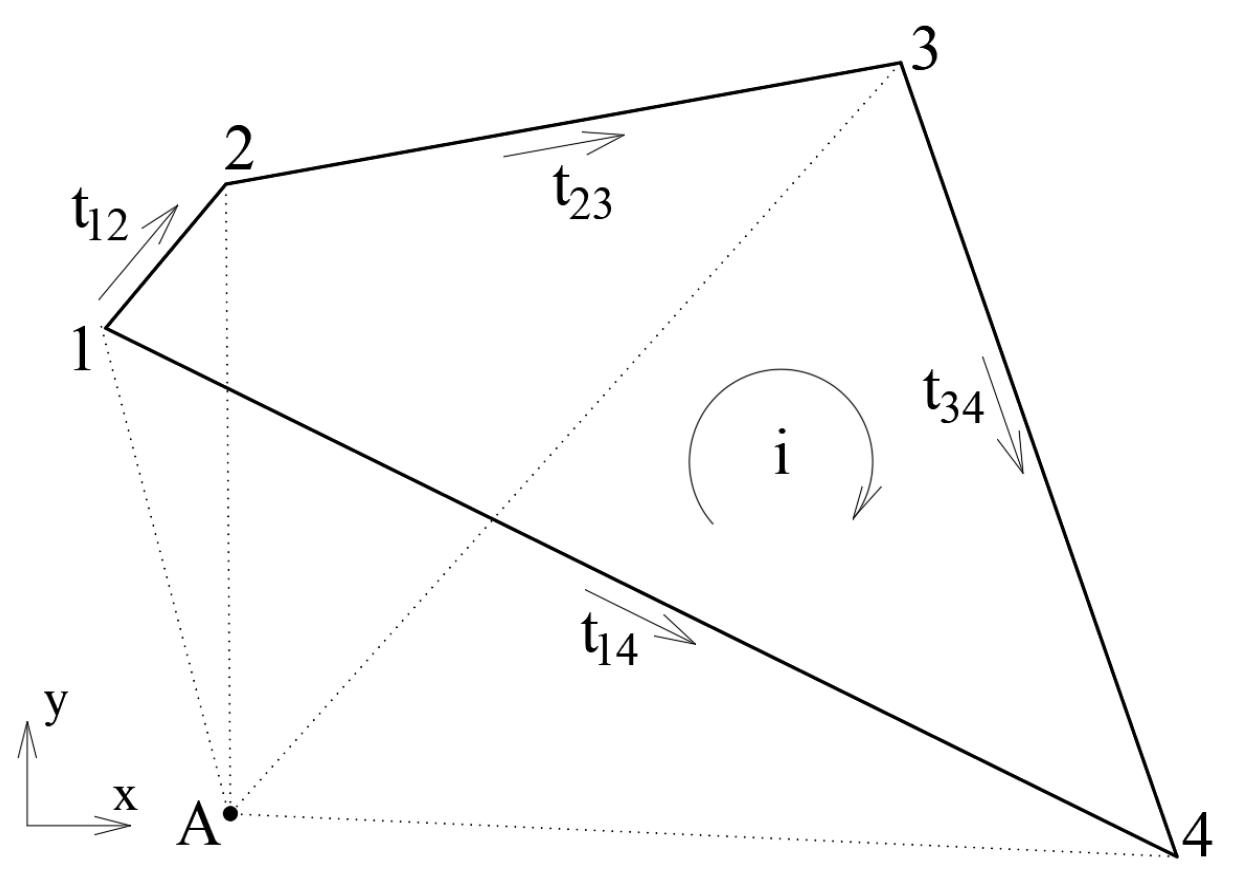
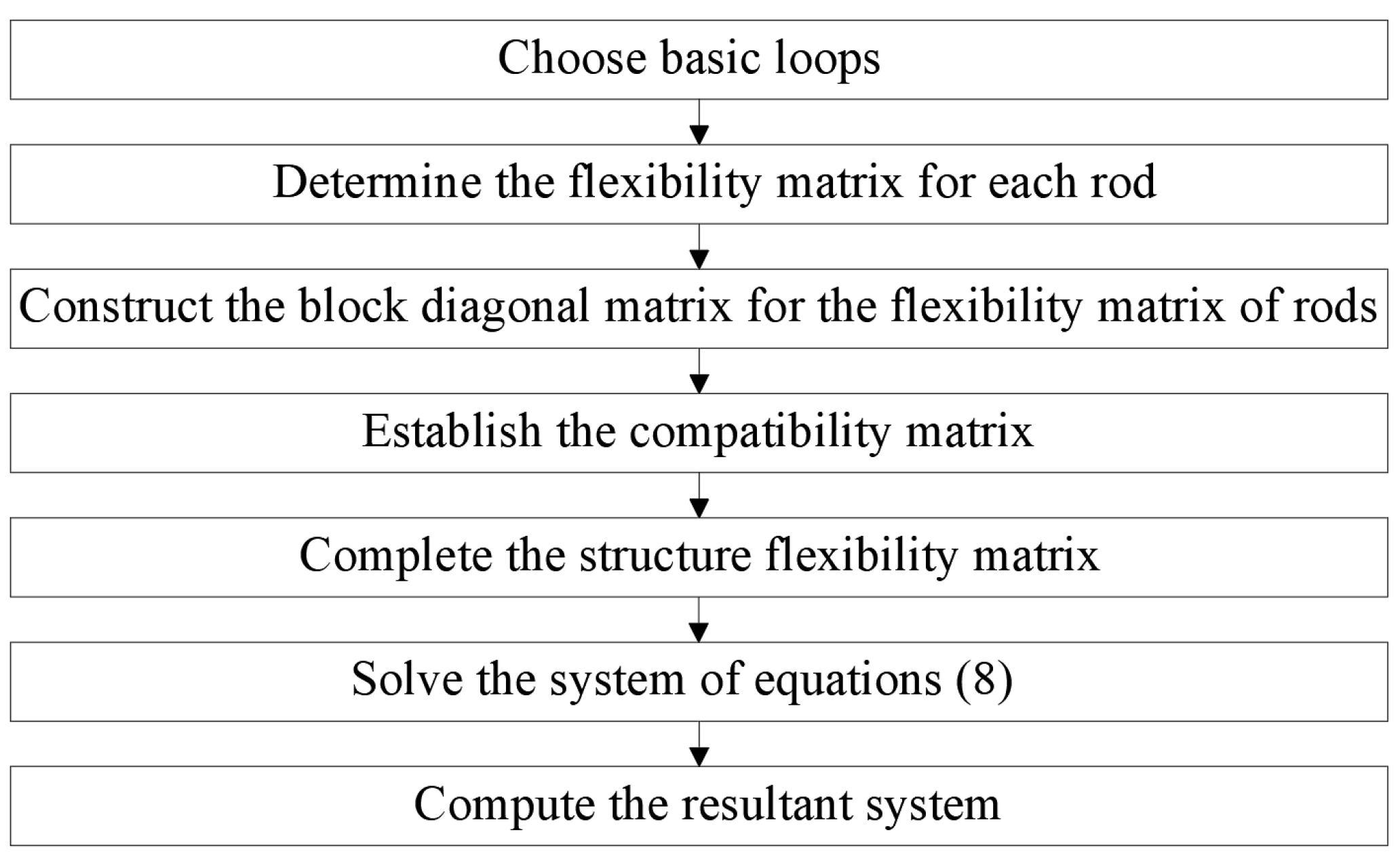
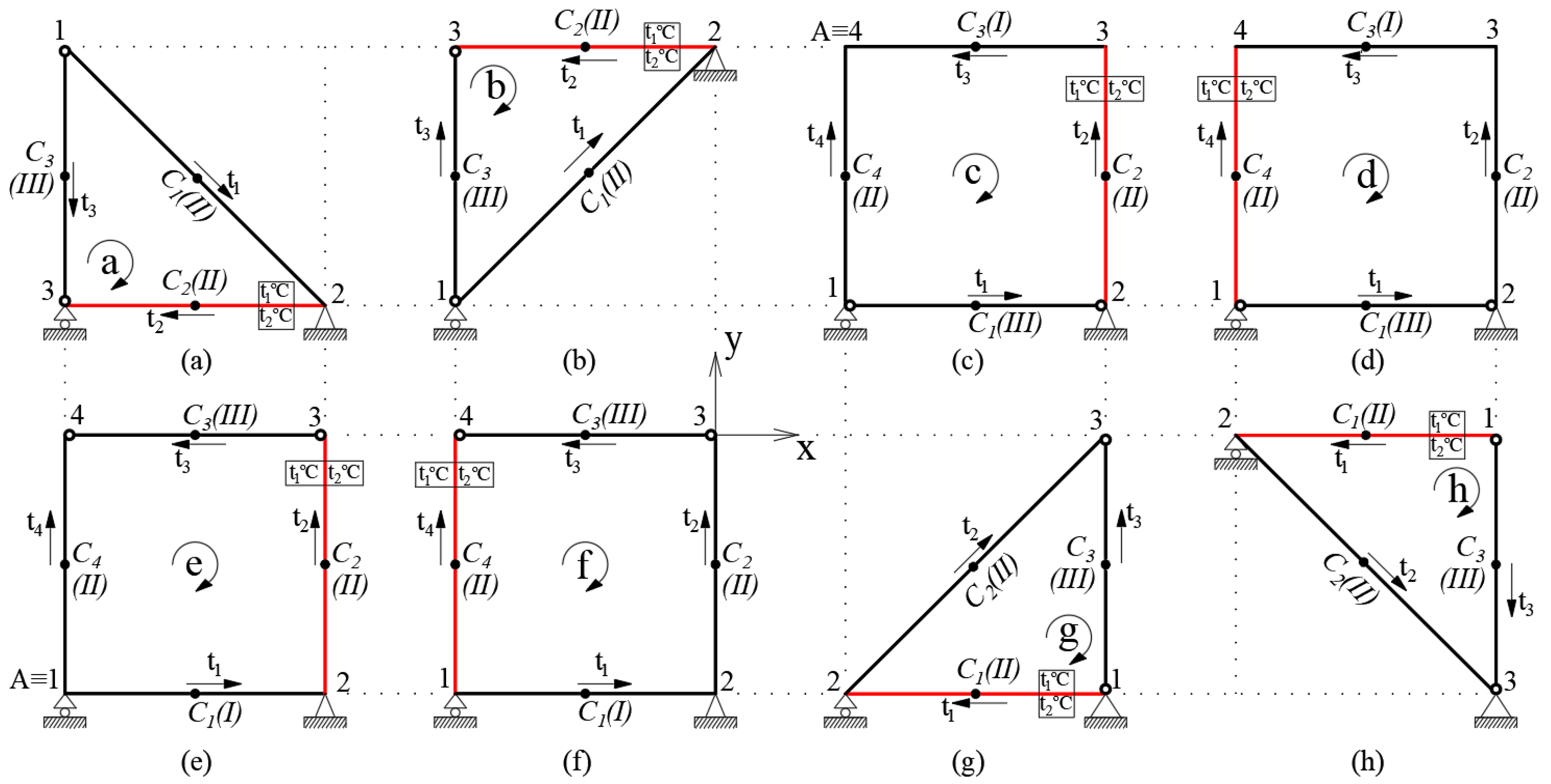
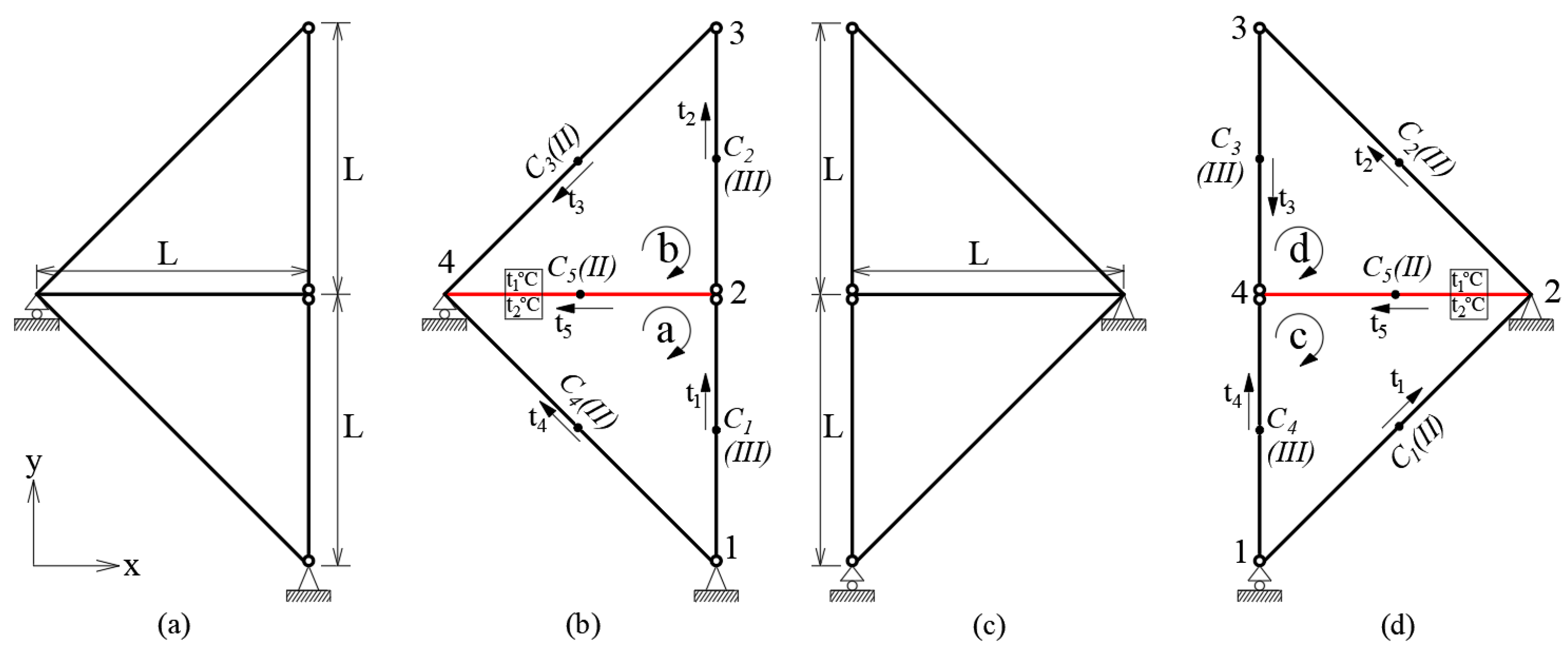
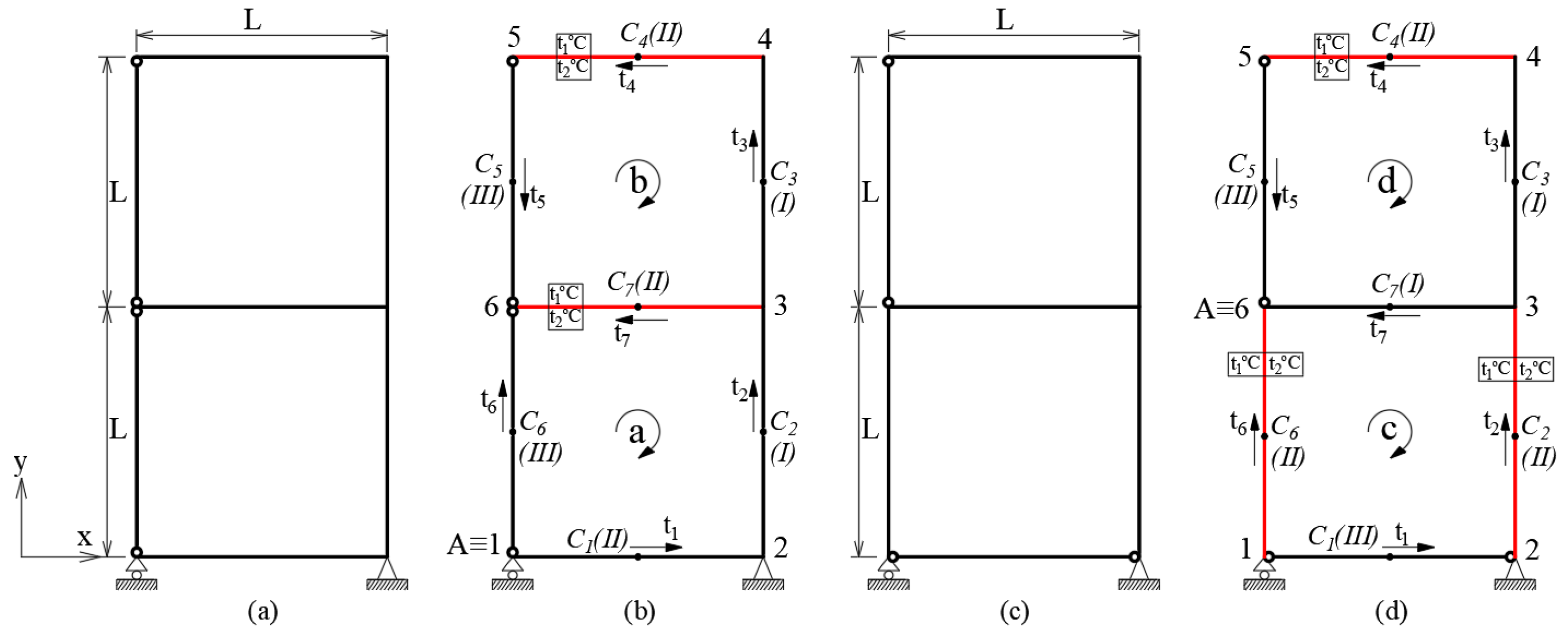


| № | LRM (Nm) | FEM (Nm) | ε (%) |
|---|---|---|---|
| 1s | 0.00 | 0.00 | 0.00 |
| 1e | −1242 | −1234 | 0.68 |
| 2s | 1242 | 1234 | 0.68 |
| 2e,3s,3e | 0.00 | 0.00 | 0.00 |
| № | LRM (Nm) | FEM (Nm) | ε (%) |
|---|---|---|---|
| 1s,1e,2s | 0.00 | 0.00 | 0.00 |
| 2e,3s,3e | 600 | 597 | 0.41 |
| 4s | 0.00 | 0.00 | 0.00 |
| 4e | −600 | −597 | 0.41 |
| № | System a | System c | ||||
|---|---|---|---|---|---|---|
| LRM (Nm) | FEM (Nm) | ε (%) | LRM (Nm) | FEM (Nm) | ε (%) | |
| 1s | 0.00 | 0.00 | 0.00 | 0.00 | 0.00 | 0.00 |
| 1e,2s | 0.00 | 0.00 | 0.00 | −878.68 | −872.61 | 0.69 |
| 2e,3s | 0.00 | 0.00 | 0.00 | 0.00 | 0.00 | 0.00 |
| 3e,4s | −878.68 | −872.61 | 0.69 | 0.00 | 0.00 | 0.00 |
| 4e | 0.00 | 0.00 | 0.00 | 0.00 | 0.00 | 0.00 |
| 5s | 0.00 | 0.00 | 0.00 | +1757.35 | +1745.21 | 0.69 |
| 5e | +1757.35 | +1745.21 | 0.69 | 0.00 | 0.00 | 0.00 |
| № | System a | System c | ||||
|---|---|---|---|---|---|---|
| LRM (Nm) | FEM (Nm) | ε (%) | LRM (Nm) | FEM (Nm) | ε (%) | |
| 1s | 0.00 | 0.00 | 0.00 | 0.00 | 0.00 | 0.00 |
| 1e | −625.00 | −622.76 | 0.36 | 0.00 | 0.00 | 0.00 |
| 2s | +625.00 | +622.76 | 0.36 | 0.00 | 0.00 | 0.00 |
| 2e | +625.00 | +622.76 | 0.36 | +197.80 | +196.13 | 0.84 |
| 3s,3e,4s | +125.00 | +124.96 | 0.03 | +659.34 | +656.29 | 0.46 |
| 4e,5s,5e | 0.00 | 0.00 | 0.00 | 0.00 | 0.00 | 0.00 |
| 6s | 0.00 | 0.00 | 0.00 | −197.80 | −196.13 | 0.84 |
| 6e | 0.00 | 0.00 | 0.00 | 0.00 | 0.00 | 0.00 |
| 7s | +500.00 | +497.79 | 0.44 | −461.53 | −460.17 | 0.29 |
| 7e | 0.00 | 0.00 | 0.00 | +197.80 | +196.13 | 0.84 |
| № | Case b | Case c | Case d | ||||||
|---|---|---|---|---|---|---|---|---|---|
| LRM (Nm) | FEM (Nm) | ε (%) | LRM (Nm) | FEM (Nm) | ε (%) | LRM (Nm) | FEM (Nm) | ε (%) | |
| 1s | 0.00 | 0.00 | 0.00 | 0.00 | 0.00 | 0.00 | 0.00 | 0.00 | 0.00 |
| 1e | −270.97 | −270.11 | 0.32 | −1083.90 | −1074.43 | 0.87 | −1354.88 | −1346.10 | 0.65 |
| 2s,2e,3s | +654.19 | +651.88 | 0.35 | −383.218 | −381.770 | 0.38 | +270.976 | +270.110 | 0.32 |
| 3e,4s,4e,5s,5e | 0.00 | 0.00 | 0.00 | 0.00 | 0.00 | 0.00 | 0.00 | 0.00 | 0.00 |
| 6s | −383.21 | −381.77 | 0.38 | +1467.12 | +1457.76 | 0.64 | +1083.90 | +1075.99 | 0.73 |
| 6e | 0.00 | 0.00 | 0.00 | 0.00 | 0.00 | 0.00 | 0.00 | 0.00 | 0.00 |
| № | System a | System b | ||||
|---|---|---|---|---|---|---|
| LRM (Nm) | FEM (Nm) | ε (%) | LRM (Nm) | FEM (Nm) | ε (%) | |
| 1s | 0.00 | 0.00 | 0.00 | 0.00 | 0.00 | 0.00 |
| 1e | −1242.64 | −1234.18 | 0.68 | −1354.88 | −1346.10 | 0.65 |
| 2s | 0.00 | 0.00 | 0.00 | +270.976 | +270.110 | 0.32 |
| 2e | −1242.64 | −1234.18 | 0.68 | +270.976 | +270.110 | 0.32 |
| 3s | 0.00 | 0.00 | 0.00 | 0.00 | 0.00 | 0.00 |
| 3e | −1242.64 | −1234.18 | 0.68 | 0.00 | 0.00 | 0.00 |
| 4s | 0.00 | 0.00 | 0.00 | −270.976 | −270.110 | 0.32 |
| 4e | −1242.64 | −1234.18 | 0.68 | −270.976 | −270.110 | 0.32 |
| 5s | 0.00 | 0.00 | 0.00 | −1354.88 | −1346.10 | 0.65 |
| 5e | −1242.64 | −1234.18 | 0.68 | 0.00 | 0.00 | 0.00 |
| 6s | +1242.64 | +1234.18 | 0.68 | 0.00 | 0.00 | 0.00 |
| 6e,7s,7e | 0.00 | 0.00 | 0.00 | 0.00 | 0.00 | 0.00 |
| 8s | +1242.64 | +1234.18 | 0.68 | 0.00 | 0.00 | 0.00 |
| 8e,9s,9e | 0.00 | 0.00 | 0.00 | 0.00 | 0.00 | 0.00 |
| 10s | +1242.64 | +1234.18 | 0.68 | 0.00 | 0.00 | 0.00 |
| 10e | 0.00 | 0.00 | 0.00 | 0.00 | 0.00 | 0.00 |
| 11s | 0.00 | 0.00 | 0.00 | +1083.90 | +1074.43 | 0.87 |
| 11e | 0.00 | 0.00 | 0.00 | 0.00 | 0.00 | 0.00 |
| 12s | +1242.64 | +1234.18 | 0.68 | +270.976 | +270.110 | 0.32 |
| 12e | 0.00 | 0.00 | 0.00 | 0.00 | 0.00 | 0.00 |
| 13s | 0.00 | 0.00 | 0.00 | +270.976 | +270.110 | 0.32 |
| 13e | 0.00 | 0.00 | 0.00 | 0.00 | 0.00 | 0.00 |
| 14s | +1242.64 | +1234.18 | 0.68 | +1083.90 | +1075.99 | 0.73 |
| 14e,15s,15e | 0.00 | 0.00 | 0.00 | 0.00 | 0.00 | 0.00 |
Disclaimer/Publisher’s Note: The statements, opinions and data contained in all publications are solely those of the individual author(s) and contributor(s) and not of MDPI and/or the editor(s). MDPI and/or the editor(s) disclaim responsibility for any injury to people or property resulting from any ideas, methods, instructions or products referred to in the content. |
© 2024 by the authors. Licensee MDPI, Basel, Switzerland. This article is an open access article distributed under the terms and conditions of the Creative Commons Attribution (CC BY) license (https://creativecommons.org/licenses/by/4.0/).
Share and Cite
Ngo, H.H.; Lalin, V.V.; Lalina, I.I.; Vavilova, A.M.; Le, T.Q.T.; Le, T.M.D. The Idea of a “Loop Fragment” of the Finite Element Force Method in the Loop Resultant Method for Static Structural Analysis. Mater. Proc. 2024, 18, 3. https://doi.org/10.3390/materproc2024018003
Ngo HH, Lalin VV, Lalina II, Vavilova AM, Le TQT, Le TMD. The Idea of a “Loop Fragment” of the Finite Element Force Method in the Loop Resultant Method for Static Structural Analysis. Materials Proceedings. 2024; 18(1):3. https://doi.org/10.3390/materproc2024018003
Chicago/Turabian StyleNgo, H. H., V. V. Lalin, I. I. Lalina, A. M. Vavilova, T. Q. T. Le, and T. M. D. Le. 2024. "The Idea of a “Loop Fragment” of the Finite Element Force Method in the Loop Resultant Method for Static Structural Analysis" Materials Proceedings 18, no. 1: 3. https://doi.org/10.3390/materproc2024018003







